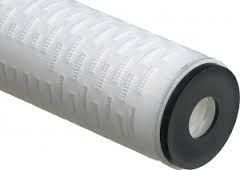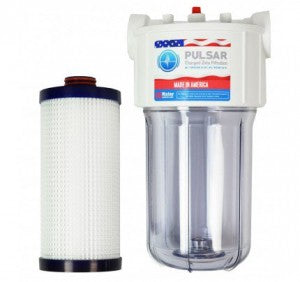Pulsar Disruptor Filter - A Game Changer
New Pulsar™ Disruptor® Filter with Ahlstrom Media

The Pulsar Disruptor Filter is a disruptive technology, in that it displaces an established technology and shakes up the industry or a ground-breaking product that creates a completely new industry. When the PC replaced the typewriter, it forever changed the way we work and communicate. Cell phones were “disruptive technology” because it allowed us to communicate from almost anywhere and the Pulsar Disruptor Filter System is “disruptive technology” in that a filter system can now reduce or remove the following contaminants:
- Bacteria
- Iron
- Virus
- Copper
- Cysts
- Lead
- Tannin
- Chromium VI
- Endotoxins
- Selenium
- Legeonella
- Tannic Acid
- Silica
- Humic Acid
- Heavy Metals
- Cryptosporidium
- Fulvic Acids
The Pulsar Disruptor filter is manufactured with Nano Alumina Fibers that have a Zeta potential of 51 millivolts. A CZF cartridge retains bacteria, virus, cryptosporidium oocysts and even tannin with its strong Zeta Potential. To removes cysts and bacteria. Unlike mechanical filters which rely on “pore size” the Charged Zeta Technology literally “secures” the contaminant. It is “absorbed” in a very real way. The filters have a long life and are easily replaceable. The Pulsar Disruptor filter media is manufactured from a naturally occurring element called boehmite, which has no known Health Side Effects. In fact, boehmite has long been used as an additive to food products and digestive analgesics. Additionally, it has passed testing for NSF/ANSI Standard 42 and 61 for potable water and USP Class VI testing and endotoxin testing. Pulsar Disruptor filter media is engineered with this 51 millivolt charge covering the entire volume and depth of the media. A Pulsar Disruptor filter accomplishes submicron filtration with a “charge” rather than “pore size” filtration, which allows for virtually zero pressure drop and high flow rates. If you compare the Pulsar Disruptor filter to “ultrafiltration” membranes, you will find dramatically higher flow rates with less pressure drop. In summary, with the Pulsar Disruptor filter, you get the following:
- High efficiency reduction
- Electroadsorptivereduction of virus
- Electroadsorptive and mechanical reduction of bacteria and endotoxin
- Mechanical removal of cysts
- Higher flow rates and lower pressure drop than membranes

DOE or SOE Filter Cartridge However, the filter choices and performance often depends upon on the seal integrity within the filter vessel. Double Open End (DOE) or Single Open End (SOE) gasket cartridges on some brands of cartridges may have very high efficiency capability but their reliance on a “knife” or pressure seal may not maintain a positive seal sufficient to stop the migration of microbial contaminants due to pressure shifting or pulsations changes from varying flow rates, which can break the seal! Without a proper seal, microbial contamination is likely to occur right from the start. Cartridges using a knife or pressure seal do not have the tolerances sufficient to act as a microbial barrier.

Pulsar Disruptor Filter with 222 Filter Seal Filter cartridges with a double O-ring seal such as a 222 or 226 (or similar design) that fit into a receiver, within the element vessel, and that provides an O-ring compression necessary to prevent by-pass are the type of filters that should be used. The Pulsar Disruptor Electro-adsorptive technology is now available at US Water Systems, and it does not rely on pore size exclusion for high levels of microbial reduction. It also does not release the retained contaminants in an event of an integrity breach. The electro-positive charge captures and retains contaminants throughout the depth of the pore structure. This method reduces microbes via adsorption + mechanical filtration not simply pore size exclusion. The electro-adsorptive charge provides a net adsorption efficiency of ~.002 um and mechanically with a mean pore size of approximately 1.2 microns. The charge field removes the negatively charged, submicron particles while larger particles are captured within the fiber structure of the media. This method reduces virus by > 4 LRV with a mechanical mean pore size of approximately 1.2 microns. Electro-adsorption provides “retention” of the organisms through these charged structures within the media and small integrity breaches, which may occur, does not produce a catastrophic release of organisms. Mechanical pore dependent membranes and filters do not enjoy this benefit. This filter media has over 400 layers of pore depth created by a wet laid non-woven manufacturing process. This results in a media having a torturous flow pattern, high flow rates at low pressure drop. The charge field results in a high initial removal efficiency as well as high loading capacity. This results in high energy saving. This media has been sold commercially for years with great results. When used with appropriate and proper pre-filtration for particulates, it provides efficient life cycles between cartridge changes. While the media performance is excellent it still requires good manufacturing practices and the integrity of the finished product is just as critical as membranes. This media requires manufacturing knowledge and experience as it can be difficult to pleat due to its 1 mm thickness and composite structure. A quality control procedure with 100% NDPT (Non Destructive Performance Test) or reverse bubble testing in alcohol solution is required at the production facility for every cartridge to insure the integrity. Spent elements and cartridges that remove microbes become a bio hazard and without an antimicrobial additive to control these microbes cannot be disposed of as normal waste. This issue is most often overlooked and the elements and cartridges are typically disposed of in the trash. The Pulsar Disruptor filter is manufactured from a naturally occurring element called boehmite, which has no known Health Side Effects. To date, US Water Systems has had excellent success in removing or reducing tannin, lead, silica and chromium 6.





48 Comments
Barry,
The only system with a Pulsar Filter that eliminates scaling is this one:
https://www.uswatersystems.com/green-wave-pulsar.html
But it is the Green Wave component that does that, not the Pulsar CZF. The Pulsar removes heavy metals, tannin and the like.
I have rust in my well water and was wondering if this filter would work to remove the rust that we shower in or is there an inexpensive way to remove the rust from our water that goes to my shower?
Nicole,
It will remove the rust (iron) from the water, but if there is a lot, it will plug the filter very quickly.
Does the CZF remove Fluoride? Are there lab tests showing this?
Thanks
No, the Charged Zeta Filter does not remove Fluoride.
We have a fairly new deep well (8 months old), it was tested, and came up with arsenic 7.5ppm, also yellow stain on fixtures, have been told most likely tannin, have a new fleck softener, no more iron trouble. My question is, will this remove both arsenic and tannin, or do I have to buy multiple systems?
Your arsenic is below the Minimum Contaminant Level, so I would just recommend a Reverse Osmosis System for your drinking water:
https://www.uswatersystems.com/drinking-water/reverse-osmosis-systems
For the tannin, you will need this: https://www.uswatersystems.com/us-water-1-charged-membrane-filter-system-10-to-20-gpm.html
Would you install the Pulsar system vs RO system for a whole house on well water?
Neither one is a stand-alone technology. I would need to see a water analysis to make that determination.
My daughter just bought a house that has well water. I come from a city water upbringing so don’t know much about this subject. She has a system that appears to have an iron filter, carbon filter, chlorinator tank and a water softener plumbed one after another. It is leaking and is also in what could be a coat closet. We wanted to replace and move the system into a storage room so she could use the closet for other purposes. She had the water tested at the tap and all is well. I tested the water out of the pressure tank and the results are as follows: no nitrates or sand, Turbidity is 257.2 NTU, pH is 5.9, Hardness is 76 and the Iron is 13.1. What system do you recommend if we updated it? Thanks for your help.
Paul
Not a simple fix, but it will work if you do this:
Step 1: Sediment/Turbidity Filter
https://www.uswatersystems.com/fusion-superfilter-professional-backwashing-filter-for-sediment.html
Step 2: pH Neutralizer
https://www.uswatersystems.com/fusion-calcite-backwashing-neutralizer-filter-system.html
Step 3: Iron Removal System
https://www.uswatersystems.com/infusion-backwashing-filter-for-iron-sulfur-and-manganese-removal.html
Step 4: Water Softener
https://www.uswatersystems.com/fusion-nlt-professional-grade-metered-water-softener.html
Step 5: Intercepter Filter
https://www.uswatersystems.com/module-1-us-water-interceptor-pre-filter.html
Let me know your thoughts!
The filter states it’s effective for removing bacteria, would I be correct in saying that it would then be an effective filter for water that had total coliform present? I am awaiting the rest of the results for my water test, but for now just want to see if this filter would be effective in this area and an option for whatever system we need to install based on the results we receive.
I would not be comfortable in answering that question until I could see a detailed water analysis. Competing contaminants can affect performance.
My water has 12ppm iron and a low ph of 6. The following has been installed but I still have tannin at the end and wondering what your recommendation is? 1. Sediment filter, 2. Aeration pump with 10×53 cylinder 3. Fleck 10×52 neutralizer with 80/20 mix of calcite/corasex resulting in 7.5 ph 4. Mangox iron filter 8×42 with magnesium oxide resulting in 0 iron. 5. UV system. Resulting in 6gpm flow.
The tannin has gotten worse since installing the aeration system? I am backwashing daily on both the mangox filter and neutralizer. There is no measurable iron in the water. The funny thing is if I turn off the aeration the water becomes clear but has 1.2ppm iron and starts staining?
Hi Mark, I do have the analysis. Where should I send it to?
Leave a comment
Please note, comments need to be approved before they are published.